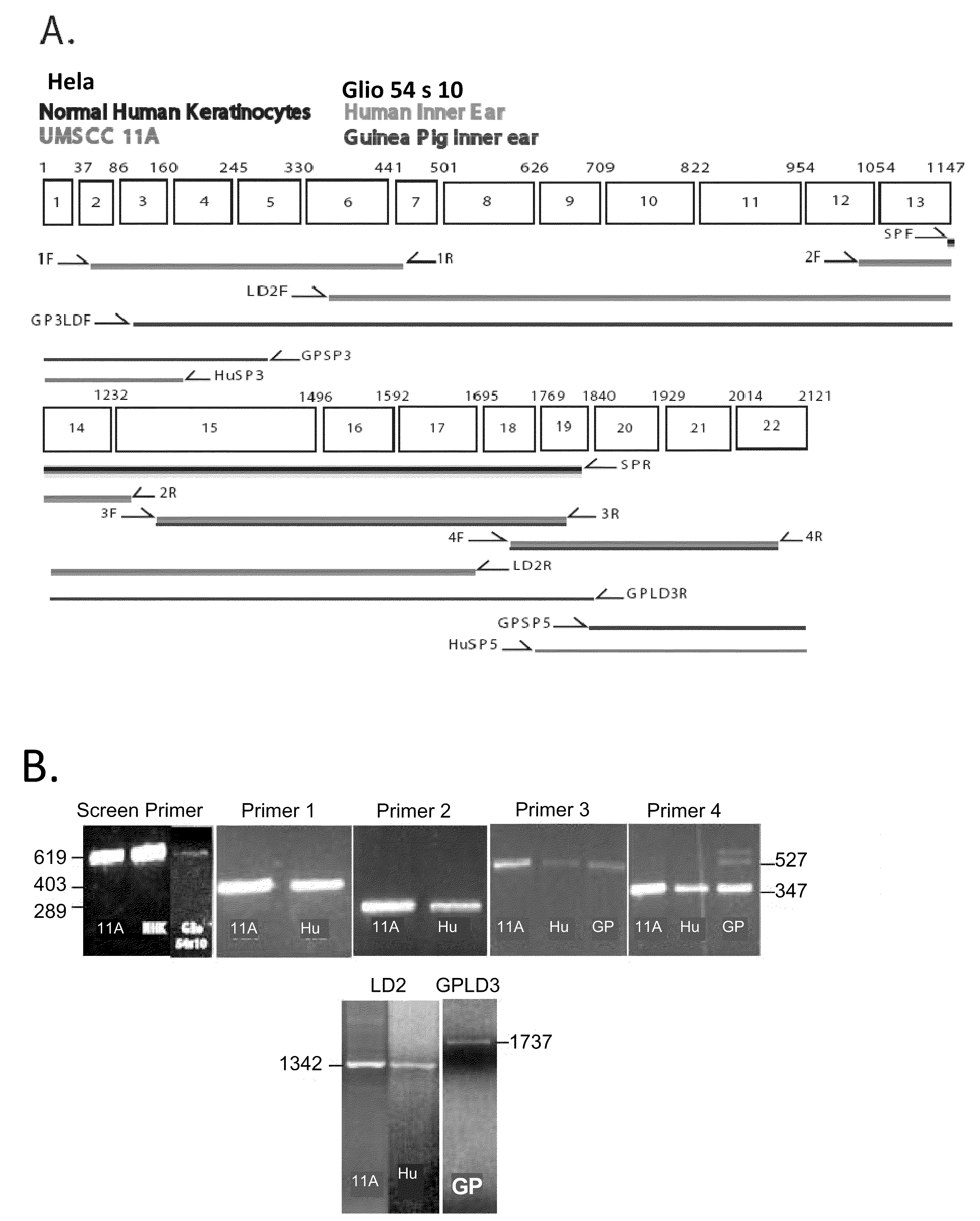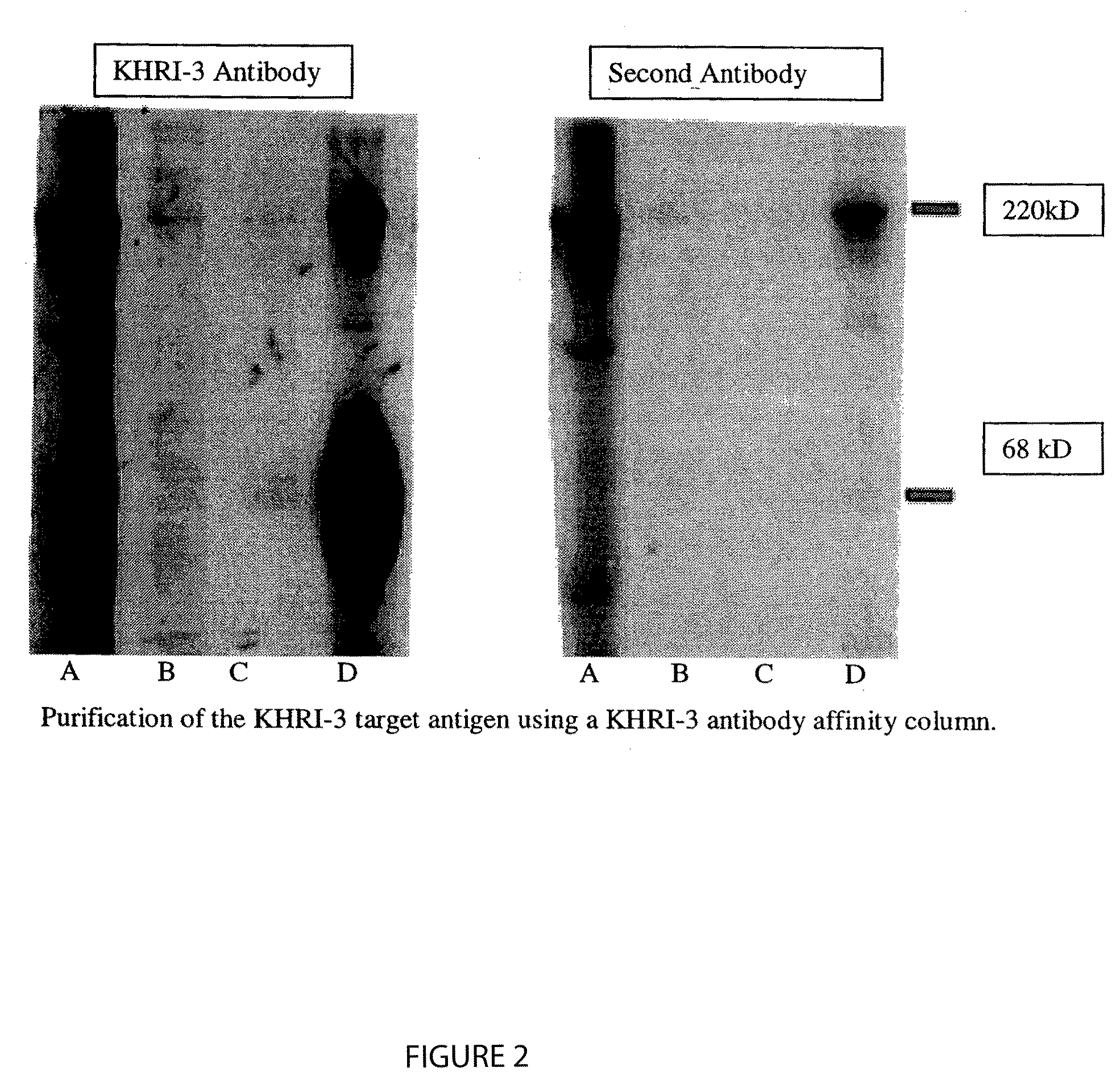Antigenic Targets Of Autoimmune Sensorineural Hearing Loss (AISNHL) And Development Of Tests For Diagnosis And Management Of AISNHL
a technology for autoimmune and sensorineural hearing loss, which is applied in the direction of peptide/protein ingredients, peptide sources, instruments, etc., can solve the problems of sudden onset, rapid progressive or fluctuating hearing loss, and use of these agents
- Summary
- Abstract
- Description
- Claims
- Application Information
AI Technical Summary
Benefits of technology
Problems solved by technology
Method used
Image
Examples
example 1
Isolation of KHRI-3 MAb
[0277]The preparation of hybridoma cells which produce KHRI-3 monoclonal antibodies was reported earlier (Zajic, G et al. (1991) Hearing Res 52:59-72). Hybridoma cells were cultured in a CELLMAX (CELLMAX® Artificial Capillary System, Cellco, Inc., Germantown, Md.) bioreactor. The bioreactor was inoculated with KHRI-3 hybridoma cells. The serum-free, antibiotic-free medium was changed to lactic acid production to maintain optimal cell growth and antibody production. Once the system was operating at optimal conditions, 45 ml of fluid containing antibody and excess cells was harvested every second day from the extra-capillary space. The IgG1 antibody binding capacity of a protein G affinity column was determined. An amount of bioreactor supernatant calculated to contain that quantity of antibody was loaded and the effluent was monitored for absorbance at A280. After all of the sample was loaded, the column was washed with binding buffer. The elution buffer was ap...
example 2
Purification and Characterization of the KHRI-3 Inner Ear Target Antigen
A. Purification by Affinity Chromatography
[0278]KHRI-3 MAb, affinity purified on protein G sepharose (as described in Example 1 above), was covalently linked to sepharose beads and used to affinity purify IESCA. Inner ear extract was passed onto the column after washing the column and was rinsed extensively with binding buffer. The samples coming off the column were monitored for protein using absorbance at 280 nm. When no protein was detected in the rinse buffer, the bound material was eluted with glycine-HCL (pH 2.0) buffer. The fractions were collected in twenty 1 ml fractions. Each fraction was monitored for absorbance at 280 nm. Pooled fractions (1-5, 6-10, 11-15 and 16-20) were concentrated to 100:1, electrophoresed on a 7% SDS-PAGE gel, transferred to nitrocellulose and Western blotted using chemiluminescence. Fraction pool 16-20 alone contained KHRI-3 reactive protein as determined by Western blot (FIG. ...
example 4
Characterisation and Role in Hearing Loss of Antibody in Autoimmune Sensory Neural Hearing Loss Patients
[0282]This example describes the characterisation and role in hearing loss of antibodies to IESCA in AISNHL patients.
A. Patient Selection
[0283]Patients with sudden onset hearing loss, fluctuating hearing and rapidly progressive unilateral or bilateral hearing loss were considered possible autoimmune patients. Sudden onset cases were included after review of the histories of several bilateral progressive cases demonstrated that these patients often reported an initial event of sudden hearing loss in one ear that subsequently progressed to involve the opposite ear. This group was included because they may represent the acute stage of early disease.
[0284]Hearing loss was defined as greater than 30 dB at any frequency or less than 85% speech discrimination in either one (unilateral) or both ears (bilateral). If the hearing loss developed within a 24 hour period and did not progress su...
PUM
| Property | Measurement | Unit |
|---|---|---|
| molecular weights | aaaaa | aaaaa |
| molecular weights | aaaaa | aaaaa |
| molecular weight | aaaaa | aaaaa |
Abstract
Description
Claims
Application Information
 Login to View More
Login to View More - R&D
- Intellectual Property
- Life Sciences
- Materials
- Tech Scout
- Unparalleled Data Quality
- Higher Quality Content
- 60% Fewer Hallucinations
Browse by: Latest US Patents, China's latest patents, Technical Efficacy Thesaurus, Application Domain, Technology Topic, Popular Technical Reports.
© 2025 PatSnap. All rights reserved.Legal|Privacy policy|Modern Slavery Act Transparency Statement|Sitemap|About US| Contact US: help@patsnap.com



